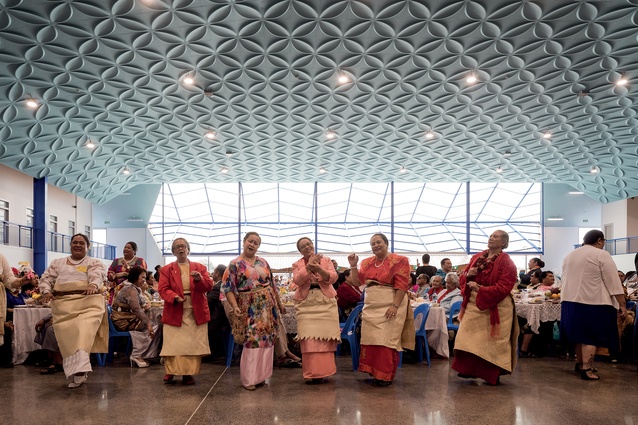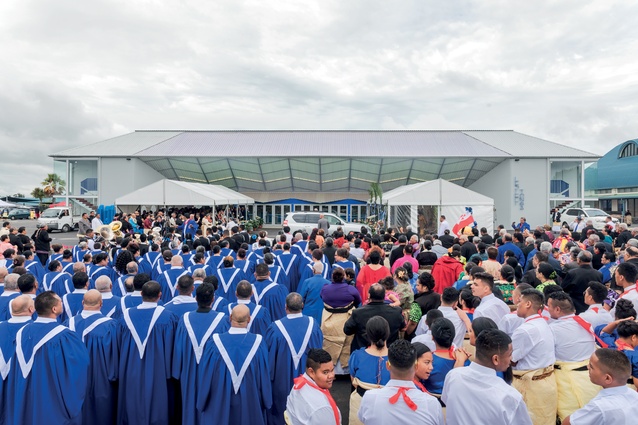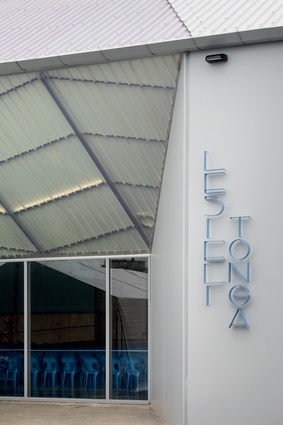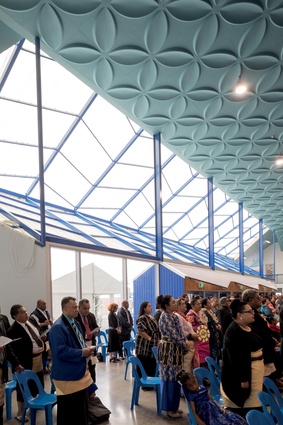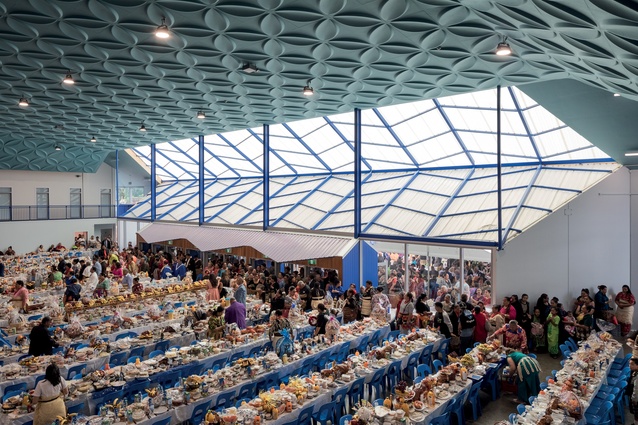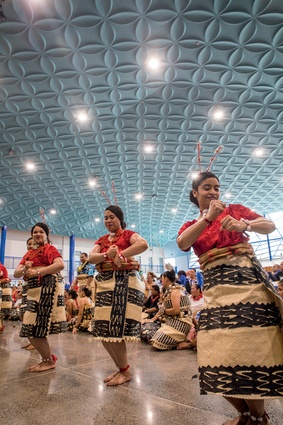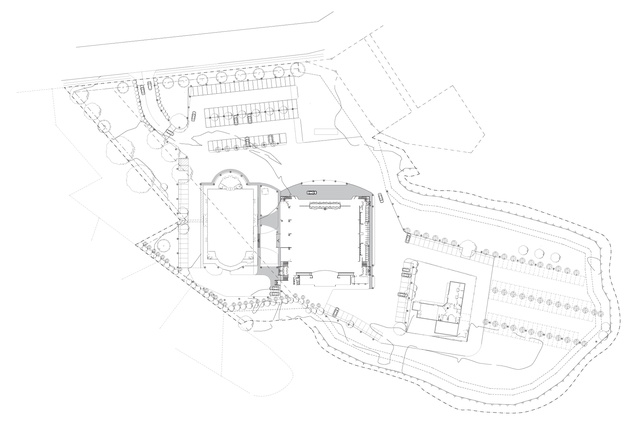A blanket of sweet frangipani: Lesieli Tonga Auditorium
A light and lofty auditorium, designed by Bull O’Sullivan Architecture for the Māngere branch of the Free Wesleyan Church of Tonga in Auckland, was lovingly funded and built by New Zealand’s Tongan community.
With a floor area equivalent to a medium-sized aircraft hangar, the Lesieli Tonga Auditorium is an imposing addition to the Free Wesleyan Church of Tonga’s site in Favona Road in Mangere. In contrast to the heavy forms of the fale-shaped 1980s’ church it sits alongside, it looks light, crisp and modern.
With simple pre-cast concrete panel cladding and metal roofing, it is as fresh and inviting as a boxed business shirt. A few cunning folds, a nice pleat or two, a transparent acrylic polymer wedge at the front and see-through sides diminish the impression of bulk without squeezing the enormous interior volume.
It was a bold undertaking for a congregation of 300 families to raise all the funds for this multi-million-dollar construction themselves without taking out any loans. Exhorted by capable Reverend Frederick Feki, the secretary for the church in New Zealand, squads of Tongan labour built the auditorium also.
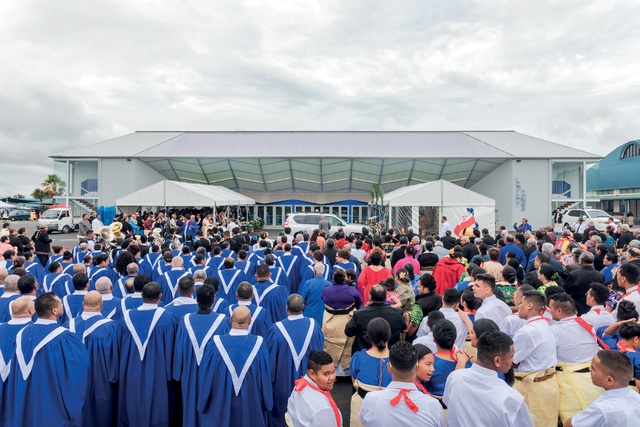
Resolution Blue (thought to symbolise ‘determination and endeavour’) is the signature colour of the church. That royal blue paint picks out the massive steel columns and beams that do the job of holding the envelope of space open over the 46m span.
As a community initiative and project, this building has its parallel in Ernst Plischke’s boxy Cashmere Community Centre designed for the Methodist Church in Khandallah, Wellington, which was considered a bold social experiment in 1952. Although it served its community faithfully for 50 years, the flimsy plaster-clad wooden structure with its uncompromising flat roof had to be demolished in 2002.
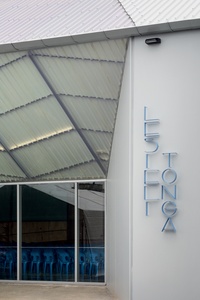
No such fate could be imagined for the stoutly robust Lesieli Tonga Auditorium, which has been designed to be multi-functional, ever-adaptable and able to bounce back from constant use. With capacity to hold up to 1,500 people at a time, with separate sleeping and ablution blocks for men and women, as well as a royal box, it has been filled with lively gatherings every weekend since opening.
Its polished-concrete floors gleamed even more after the day-long opening ceremony of speeches, dancing and singing ended with the throngs sitting down to tiered tables laden with food – 300 spit-roasted pigs, each topped with three steamed crayfish, and towers of fresh fruit. Facing due north, it is cosy even on the dreariest winter’s day and cooled in summer by air currents drawn through its 14m height.
Adamantly functional, the building still manages to offer some lyrical allusion. Laying the purlins diagonally across the rafters inside the translucent roof structure created a wavy effect that makes the overhang seem to ripple like the ocean, or arc up and down like the wings of a frigate bird.
Capture and release are symbolised as you are beckoned in through the two sets of 18 doors which hold you briefly in the wood-panelled entrance chamber before you fly into the wide expanse of the hall, your spirits lifted by the sight.
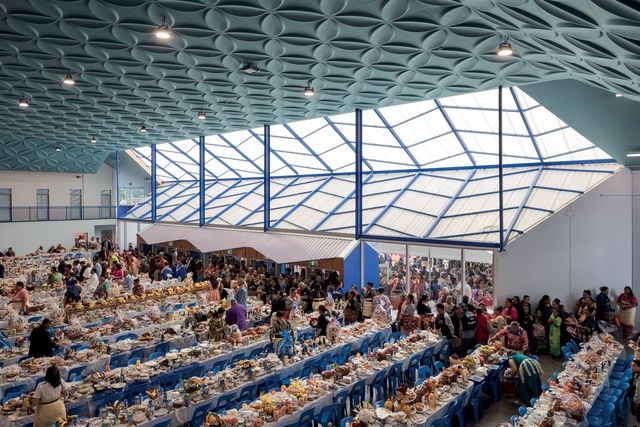
It is in the auditory, rather than the visual, realm that the building’s performance is outstanding, however. Glorying in the size and splendour of its choirs and brass bands, the Free Wesleyan Church of Tonga’s music deserves to be heard.
Custom-designing a patterned acoustic tile based on Tongan ngatu for the vaulted ceiling, architect Michael O’Sullivan created “a blanket of sweet frangipani” to envelop all who enter. Tinted a heavenly blue, this high-performance surface is studded with lights like a star map, the traditional navigational aid for Pacific voyagers.
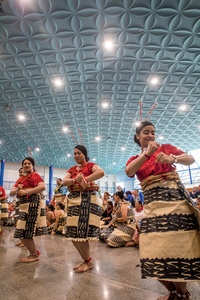
For the Tongans, the frangipani is the flower of the welcoming lei, here transformed into a shawl of flowers cast high in celebration. Its powder blue is complemented by the warm reds and shiny browns of the freshly-made ngatu, made by Tongan women, which cloak the walls.
O’Sullivan feels it was both a privilege and a responsibility to be selected to design a building that not only represents a nation but also has to be fit for a king and queen. King Tupou VI took care in choosing the name to be bestowed on the new building.
Lesieli Tonga was the first female dux of Tupou College in 1871, and went on to become the tutor for Queen Salote Tupou III after her mother died. People building and using the hall should aspire to attain the qualities of integrity and reliability of its namesake, the king thought.
Lesieli Tonga’s portrait hangs at the back of the stage on a wall of charred Portuguese cork, darkened like coconut husks, which the architectural practice of Bull O’Sullivan donated to the project in keeping with kaupapa Pasifika.
O’Sullivan’s family also gave the lettering (which he designed) that forms the name of the building on the exterior. Bull O’Sullivan’s greatest gift, however, is in showing how, by working collaboratively and ingeniously, a simple but elegantly proportioned building with graceful detailing can outperform much grander edifices.

